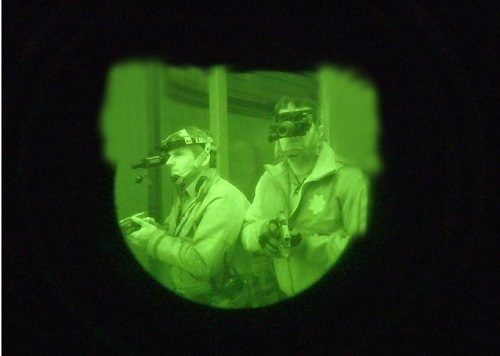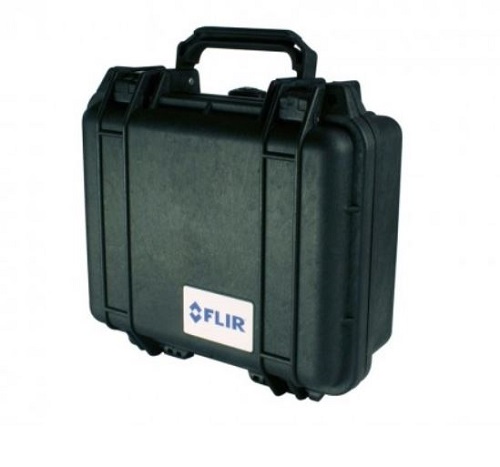Night vision Has become a vital tool for the U.S. military. Pilots operate fighter planes and helicopters using night vision devices.
Militants on the Afghanistan territory use night vision goggles to locate and remove Taliban rebels. Even unmanned aerial vehicles (UAVs) have the most recent thermal cameras.
Such tools are rarely used in law enforcement, but as prices drop, they're becoming more prevalent.
However, law enforcement officers continue to be uncertain about what night vision can and cannot do and what they should know before purchasing it.
1. What Should I Call It?
One of the things about night vision is what to call this tool.
There are two main types: the image intensifier tube device and the infrared (thermal) devices.
It's a common misnomer that just the image intensifier systems--known as "I²" in the industry--should be referred to as "night vision."
2. What's The Difference?
An image intensifier night vision system is an optical instrument that precisely what you would consider from the name.
It takes available light and intensifies it.
The new I² systems can work in pitch darkness. Infrared systems evaluate the difference in heat and create an electronic image of what is radiating that heat.
3. How Does I² Night Vision Work?
I² technology magnifies the number of received photons (light packs ) from sources like moonlight and starlight.
Incoming light strikes a photocathode plate within the image intensifier tube.
The light photons are magnified and carried through a vacuum tube. They hit a microchannel plate, which causes the picture to illuminate a photo in an identical pattern as the light striking the photocathode.
The resolution in the I² apparatus is measured in line pairs per millimeter (lp/mm).
4. How Does Thermal Work?

Handheld thermal or infrared night vision systems use a sensor called a micro manometer that reads the differences in temperature between an object and its surroundings to produce an image of that object.
The data from the microbolometer is then transmitted to a display so the operator can see it. The thermal night vision is not optical.
5. What's With the I² Generations?
Generation 0 And Generation 1 doesn't matter now.
Generation 2 -- Gen 2 devices are much brighter and much more capable of light intensification than Gen 1.
They're also much smaller due to photocathode plate technologies and microchannel plate. Supplied to NATO allies from the U.S. military, the technology was copied and enhanced by the Soviets to make Gen 2+.
Today, exceptional Gen 2+ programs are still being produced in Russia, Belarus, and Western Europe.
Generation 3 -- Up to 15,000 hours of use and excellent light intensification are the advantages of Gen 3 tubes, which can't be exported outside the U.S. except with the Department of Defense's direct consent. The Gen 3 systems are Gen 3+ or Gen 3 Pinnacle. All Gen 3 tubes are produced by EOTech L-3 or ITT Exelis regardless of who makes the entire system.
6. What is Auto-Gating?
Auto-gating basically prevents glowing lights from whiting out the system or making temporary blindness of the operator.
Additionally, it assists the I ² tube to keep the highest resolution possible during a variety of conditions. It's particularly significant on I² systems, which are used for aviation or on rifle optics.
However, it is a feature of later Gen 3 tubes, it can also be found on some Gen 2+ systems.
7. What Can I² Cost?
It is all about quality when you talk about I² systems.
The question of quality isn't only about the image intensifier tubes, but also about the optics, and the attributes.
The popular image intensification tools used by law enforcement would be the PVS14 monocular systems and a vast array of variants of the platform.
A good Gen 2+ monocular system will run you around $2,000. If you need a Gen 3 monocular, you are possibly looking at $ 4,000.
Additionally, features on such systems, specially dedicated weapon sights and attachments, can substantially raise the price.
8. What Does Thermal Cost?
Three years ago, handheld thermal camera devices suitable for law enforcement operations cost as much as $10,000.
Subsequently, FLIR, the firm that makes the majority of the microbolometers used in handheld thermal devices, began to sell collections of infrared sensors to luxury car manufacturers.
This mass usage of infrared sensors has lowered the prices on primary handheld thermal cameras to approximately $4,000 for excellent quality.
9. How To Judge Quality Of Night Vision?

For thermal, it's simple. It depends on resolution, with 640 x 480 generally are the best for handhelds.
A fantastic system is 320 x 240, and there are several applications where 240 x 180 will do the job. Each increase in the resolution will cost you about $1,000 more on the typical handheld unit. You also need to look at features such as video capture and stills.
Judging the quality of I² equipment is much more complicated.
The quality of any I² The tool depends on its optical characteristics and its image intensifier tube. You could get the best Gen 3 tube in the marketplace and pair it with bad optics, and you would have a stbad system.
So think yourself as much with the optics as the tube. This is particularly true about the edges of the picture area. You do not want an effect or distortion.
The resolution on an I² system is quantified in lp/mm, with 64 to 72 lp/mm being the gold standard.
Most applications do not need a resolution that sharp; actually, some experts argue that this level of resolution exceeds the capacity of the human eye.
Most specialists recommend a resolution of 45 lp/mm for most surgeries.
10. Can Thermal Device Be Tested Before Buying?
Most sellers of law enforcement night vision devices have great teand test (T&E) programs.
Many will even enable you to use the equipment on operations before you purchase.
Check with your seller. Then turn the stuff over to your knowledgeable night vision operator for a comprehensive test.
11. Are There Cheaper Alternatives?
Absolutely. It's essential to not forget that I2 night vision was designed to be used on distant battlefields where the only illumination is moonlight or starlight.
You might not require that type of image intensification. Automatic camera sensors like a complementary metal-oxide-semiconductor (CMOS) or a charge-coupled device (CCD) can provide considerable low-light capabilities.
Low-light imaging systems with these detectors sell for under $500. They can be the best tools for patrol officers in metropolitan or well-lit regions who wish to see what's happening in the shadows.
Under these conditions, they may be even more potent than I2 night vision.
12. How To Maintenance Night Vision?

Don't drop it. Do not store it for lengthy periods with batteries inside. And keep the lens covers on it till you are ready to use it.
Most systems have protective cases. Finally, cover the lens with transparent glass filters.
These "sacrificial windows" will shield your lenses from dirt and scratches. Thermal devices are solid-state, so there is not much to break. Don't drop them.
13. Do I Need Special Training?
Anyone's body can slap on an I² device and walk around in the dark. However, to get the most out of your devices, invest in training and equipment.
Some sellers give training. You may also have former military operatives in your company who can train the rest of your officers.
Finally, you may need to hire a training company. Your I² vendor can apparently recommend one.
14. How Long Do Night Vision Devices Last?
Thermal cameras are solid-state and with proper care can last a lifetime.
I² systems have a finite lifespan due to the coatings on the tubes.
A sound Gen 2+ system ought to provide up to 5,000 hours of use.
A Gen 3 system can give you up to 15,000 hours of operation, but 12,000 is probably more likely.
If you wish to extend the lifespan of I2 equipment, shut it off when not in use.
15. Why Can I² Green?
It was determined long ago that black and green give the most detail in night-vision systems. But they don't need to be black and green.
Some systems use black and white images, which some users prefer. They say the white and black aren't as bright and doesn't fatigue their eyes as much as the black and the green.
Frequently Asked Questions

1. How much will I be able to see with Night Vision?
A: That is like asking who's going to win the Super Bowl in early September. There are many factors, such as how big is the object you're looking for, is it a house, a person, or a mouse.
If it's a person that you're considering, with a fantastic Gen 3 piece of gear you might be able to "detect" that individual 300 yards away, however, you might not be able to "recognize" if it's a boy or girl until they are 150 yards away.
This is the difference between "recognition range" and "detection range."
Another significant factor is the amount of light available; is it a bright clear night, or is it a cloudy night with no moonlight.
The brighter the night, the more distant you will see, and the better your recognition range and detection range will be.
What generation and also the levels within each generation will make a big difference in how distant you will be able to see, especially on lower light nights with a 1/4 moon or less.
A Gen 3 device's recognition levels can be several times farther than a Gen 1 device.
The device itself will have a substantial effect on distance as some tools are made for longer distances, such as long-range binoculars and night vision binoculars.
However, a binocular will sacrifice navigation ability, the field of view, extra weight, and hands-free operation for distance.
2. What's an I.R. Illuminator, and do I need one?
A: An I.R. illuminator is a system that projects out infrared light very similar to a flashlight.
Infrared light is virtually invisible to the naked eye, but it is visible to night vision gear.
Devices include a built-in infrared illuminator and many of which are short-range flooding light style, which is great for close-range and indoor night vision use - about 30 yards maximum distance.
There are several circumstances when even the best Gen 3 devices require the support of an I.R. Illuminator such as dark inside buildings anytime moonlight and starlight aren't getting into the screening area like in wooded surroundings and in areas of shadows created by trees, buildings or other obstacles.
Medium and long I.R. Illuminators are different from the integrated illuminators. These external illuminators may send a spotlight like a beam of light out to distances of up to 500 yards.
These valuable accessories can improve the effectiveness of an optic significantly. The downside to any infrared illumination is that if you're attempting to operate conversely, anyone with a Gen 1 device will have the ability to spot you like a shining beacon.
Bear in mind that all Gen 1 equipment has built-in I.R. illumination that is always on. The cause for this is that you would see extremely little with Generation 1 products without the I.R. light. Gen 2 and Gen 3 equipment have over 1000 times more light amplification than Gen 1, so an always-on I.R. illuminator isn't essential.
Devices having built-in illuminators like Generation 2 or better have on/off controls for their illuminators. With Gen 1, there is no switch since the illuminator is always on. In summary, with the quality equipment, you won't always require an infrared illuminator.
However, in the circumstances, it may double your device's ability and allow you to find things that would be impossible to view without a long-range illuminator. Nightvision4less suggests a long-range I.R. illuminator as your number one accessory.
3. How durable is the night vision device? What if it drops?
A: People often ask, "what should I drop my Night Vision?". The answer is you will break it.
Do not forget that devices are delicate equipment, and the inner parts contain precision electronic equipment and aren't meant to take the effect of dropping.
The answer is that it depends on how you drop it or what you drop it on along with other factors. One variable that does make a difference is the sort of device you have.
Some products are Mil-Spec quality and are prepared to take more bumps and bruises like PVS-7 Goggles and PVS-14 Monoculars with some versions comprising a 5-year warranty, and a few unique Hand Select models with a 10 Year Warranty.
Overall it is suggested that you take good care of your night optic and keep it like the costly electronic device that it is. If you're going to randomly drop your device, try and make sure it drops into something soft or a heap of feathers!
4. Is it legal to get Gen 3 night vision? And do I want any sort of permit?
A: This is, in fact, a question from many users once they get their new Gen 3 apparatus. They look through it for the first time and state, wow, is that even legal to have? The answer is that it's entirely legitimate for own Generation 3 night vision.
However, it's a federal crime to transport or send it out of the U.S., and no, you don't require a license or need to become law enforcement to have Gen 3 inside the U.S.
5. Q: What else can I do with night vision?
A: Night vision devices can be used for many different things such as wildlife inspection, what animals will do when they are unaware you are seeing them.
Other common uses are hunting, camping, home security, night birding, night fishing, night boating, night photography, caving or spelunking, and other exciting things.
Among the most overlooked and awe-inspiring uses of higher performance devices is nighttime sky viewing/astronomy. Look upon a clear night with a fantastic Gen 3 piece of equipment, and you'll just about fall over at what you will see... Stars, ten times more stars than you have ever seen before, also planes, satellites, and other "night sky objects."
Do not blame us for the stiff neck yore going to have from looking up so long, or get a comfortable lounge chair. So yes, there are plenty of cool uses for a good piece of night vision equipment.